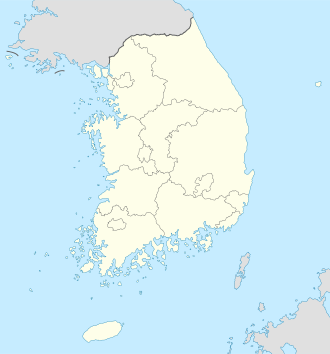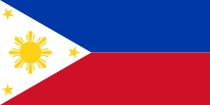Incheon
| Incheon | |||
| — Metropolitan City — | |||
| Korean name transcription(s) | |||
| - Hangul | 인천광역시 | ||
|---|---|---|---|
| - Hanja | 仁川廣域市 | ||
| - Revised Romanization | Incheon Gwang-yeoksi | ||
| - McCune-Reischauer | Inch'ŏn Kwang'yŏkshi | ||
| Korean name short form transcription(s) | |||
| - Hangul | 인천 | ||
| - Revised Romanization | Incheon | ||
| - McCune-Reischauer | Inch'ŏn | ||
 |
|||
|
|||
 Incheon
|
|||
| Coordinates: | |||
| Country | South Korea | ||
| Region | Sudogwon | ||
| Founded | 1883 as Chemulpo | ||
| Subdivisions |
List
|
||
| Government | |||
| - Type | Metropolitan City | ||
| - Mayor | Ahn Sang-soo | ||
| - Council Chairman | Chang-Gyu Park | ||
| Area | |||
| - Total | 964.53 km² (372.4 sq mi) | ||
| Population (2005 est.)[1] | |||
| - Total | 2,628,000 | ||
| - Density | 2,724.6/km² (7,056.8/sq mi) | ||
| Time zone | Korea Standard Time (UTC+9) | ||
| Dialect | Seoul | ||
| Flower | Rose | ||
| Tree | Tulip tree | ||
| Bird | Crane | ||
| Website: http://english.incheon.go.kr/ | |||
Incheon is a metropolitan city and a major seaport on the west coast of South Korea, near Seoul.
Human settlement at the location goes back to the Neolithic. In modern times Incheon became important because its location on an estuary made it a good harbor; when the port was founded in 1883, the city, called Chemulpo at the time(hangul: 제물포, hanja: 濟物浦, revised: Jemulpo), had a population of only 4,700. Incheon is now home to almost 2.5 million people, is South Korea's third largest metropolis, and is also under the control of one of the two free economic zone authorities in Korea, aimed at attracting foreign investment; the city aims to turn itself into a financial and corporate hub along with the Busan-Jinhae Free Economic Zone Authority.
The city boundaries include an area of 964.53 km2 (372.41 sq mi), of which 21 percent is rice paddies and another 44 percent is forested.
Incheon is regarded as part of the greater Seoul metropolitan area due to its close proximity to the capital, and the fact that the Seoul Metropolitan Subway and the Incheon Subway systems are linked. Incheon is, however, a major city in its own right and is a separate jurisdiction from Seoul.
Contents |
History
The first historical record of the Incheon area dates back to 475 A.D. during the reign of King Jangsu of Goguryeo by the name of Michuhol. The area underwent several name changes with successive kingdoms and dynasties. The current name was established in 1413 A.D. during the reign of King Taejong of Joseon. The name Jemulpo was not widely used until the opening of the port in 1883.[2][3]
The city was the site of a Japanese POW camp during World War II.
On September 15, 1950, during the Korean War, Incheon was the site of the Battle of Incheon, when United States troops landed to relieve pressure on the Pusan Perimeter and to launch a United Nations offensive northward. The USS Inchon (MCS-12) was named after the tide-turning battle that ensued.
Incheon was originally part of Gyeonggi Province, but was granted Directly Governed (now Metropolitan) City status on July 1, 1981.
Climate
| for Incheon | |||||||||||||||||||||||||||||||||||||||||||||||
|---|---|---|---|---|---|---|---|---|---|---|---|---|---|---|---|---|---|---|---|---|---|---|---|---|---|---|---|---|---|---|---|---|---|---|---|---|---|---|---|---|---|---|---|---|---|---|---|
| J | F | M | A | M | J | J | A | S | O | N | D | ||||||||||||||||||||||||||||||||||||
|
22
1
-7
|
23
3
-5
|
40
8
1
|
87
15
7
|
83
20
12
|
108
24
17
|
285
27
21
|
252
28
22
|
152
25
17
|
48
19
10
|
50
11
3
|
20
4
-3
|
||||||||||||||||||||||||||||||||||||
| temperatures in °C precipitation totals in mm source: climate-charts.com |
|||||||||||||||||||||||||||||||||||||||||||||||
|
Imperial conversion
|
|||||||||||||||||||||||||||||||||||||||||||||||
Incheon has a humid continental climate (Köppen climate classification Dwa). Incheon's climate is about average compared to the rest of Korea, with 8 locations being cooler and 10 locations being warmer, and with 9 locations being wetter and 9 locations being drier. [4]
Incheon experiences each of its four seasons, distinctly feeling the rise and fall of temperature and humidity. The temperature however, never rises to an extreme, and the climate of the city is essentially mild. Incheon is swept by the seasonal winds as the northwesterly winds strike the city in the winter and the summer in Incheon is affected by gusts of the warm southwesterly winds. [5]
Major events
Incheon will host a series of major international events. The Global Fair & Festival 2009 Incheon, Korea will be held in the Songdo District in August 2009. It will open on August 7 and run through October 25 for a period of 80 days. It is a comprehensive international event with global institutions and corporations as participants.
Incheon has also won the bid to host the Asian Games in 2014.
Education
On February 27, 2007, Incheon declared itself an "English City," and inaugurated the "Incheon Free English Zone" program. The goal of the program is to make Incheon as much an English speaking city as Hong Kong and Singapore are. This is for the ultimate purpose of establishing Incheon as a commercial and business hub of northeast Asia (see Free Economic Zone below). The official slogan of the program is "Smile with English."
Higher education
Incheon is home to several colleges and universities:
- Gyeongin National University of Education
- Gachon Medical School
- Gachongil College
- Gyeongin Women's College
- Inha Technical College
- Inha University
- Incheon Catholic University
- Incheon City College
- University of Incheon
- Jaineung College
- See also: Category:Universities and colleges in Incheon
Sports
Incheon is home to the following professional and semi professional sports teams:
Baseball
The KBO team SK Wyverns.
Basketball
The KBL team Incheon ET Land Blackslamers.
Football (Soccer)
K-League team Incheon United.
The National League team Incheon Korail.
Munhak Sports Complex
The Munahk Sports Complex houses both a football stadium and a baseball stadium. The football stadium was Incheon's venue for the 2002 Football World Cup, and is also the home venue for Incheon United. The baseball stadium is the home venue for the SK Wyverns.
On April 19, 2007, Incheon was selected as the host city for the 2014 Asian Games, beating out New Delhi. [6]
Transportation
Incheon is a major domestic and international transportation hub for Korea.

Air
Incheon International Airport, a regional air hub, is South Korea's primary international airport.
There was a total of 160,843 flights (157,134 international, 3,709 domestic) to and from Incheon International Airport in 2005, an average of 441 flights (431 international, 10 domestic) daily. 59.7% of the flights were serviced by Korea’s two national carriers, Korean Air and Asiana Airlines, with foreign carriers servicing the remaining 40.3%, which breaks down as follows: China 45,125 flights {28.1% of total}, Japan 32,352 {20.1%}, Southeast Asia 30,567 {19%}, Americas 27,916 {17.4%}, Europe 11,082 {6.9%}, Domestic 3,709 {2.3%}, Oceania 2,811 {1.7%}, others 7,281 {4.5%}.
Incheon Tiger Airways is expected to begin operations in 2008 as a low cost airline as a subsidiary of the Singapore based Tiger Airways owned 49% by the city of Incheon.
Sea
Incheon Sea Port is second largest in Korea after Busan Sea port.
The International Passenger Terminal located at the port offers ferries to four cities in China: Dalian, Qingdao, Tianjin, and Weihai. There are also ferries to Incheon's outlying islands as well as Jeju Island.
Buses
Incheon Bus Terminal, located at its eponymous subway stop, offers express bus transportation to all parts of Korea. Many city bus lines offer transportation within city limits as well as to the neighboring cities of Bucheon, Gimpo, Seoul, and Siheung.
Many BRT lines offer transportation between Seoul and Incheon.
Train
Local service to Guro Seoul, Cheongnyangni, Uijeongbu and Soyosan Station is offered by Seoul's subway Line 1. The line has 11 stations within Incheon and connects to the Incheon Subway at Bupyeong station.
Rapid service on the same line to Yongsan Station in Seoul depart from Dongincheon station and stops at major stations.
The Airport Express (A'Rex) line was opened between Gimpo Airport and Incheon International Airport in March 2007. The line has 6 stations on 40.3 km (25.0 mi) of track and is operated by Airport Railroad Corporation. It connects to the Incheon Subway at Gyeyang station and Seoul Metropolitan Subway at Gimpo Airport station. It will be extended to Seoul station by December 2009. The extended line has 4 stations on 20.7 km (12.9 mi), and the existing line will have 2 more stations.
Subway
The Incheon Subway has a single subway line serving the city. It connects to the Seoul Metropolitan Subway system at Bupyeong station, and A'Rex line at Gyeyang station. The line has 22 stations on 24.6 km of track. The Incheon subway is operated by the Incheon Rapid Transit Corporation(IRTC).
Extensions and addidtions are planned: IRTC is constructing extension of Subway line 1. It will go from Dongmak station to International Business District in Songdo international city by Apr 2009, and there are plans to construct a second line, Line 2. It will extend from Oryu to Incheon Grand Park (exact route undetermined). Korail is constructing a new subway line from Incheon station to Suwon station by 2013. It will have 10 stations within Incheon. SMRT (one of three operating companies of Seoul Metropolitan Subway) also has to extend Seoul Metropolitan Subway Line 7 to Bupyeong-gu office by 2011 and provide transfers to the Incheon Subway system. It will have 3 stations within Incheon including the Bupyeong-gu office station.
Free Economic Zone
The Incheon Free Economic Zone consists of the three regions of Songdo, Cheongna, and the island of Yeongjong and have a total area of 51,739 acres (20,938 ha). The goal of IFEZ is to transform these three areas into hubs for logistics, international business, leisure, and tourism for the Northeast Asian region. The term 'Free Economic Zone' applies to the development in these three areas with the aim of improving the business environment for foreign-invested enterprises and the living conditions for foreigners. The zone is a specially designated area to create the most favorable business and living environment where foreign nationals can live and invest freely and conveniently. Incheon's Free Economic Zone, the first in Korea, was officially designated by the Korean government in August 2003. IFEZ is planned to be a self-contained living and business district featuring air and sea transportation, a logistics complex, an international business center, financial services, residences, schools and hospitals, and shopping and entertainment centres.
New Songdo City
Songdo International city began development in 1994 and is being built on reclaimed land. It is designated to become a center of diverse international businesses, a hub for international trade, an area for knowledge-based technologies, and a place for eco-friendly urban living.
- Development size: 13,162 ares
- Planned population: 252,000 persons
- Construction duration: 1994~2020
Yeongjong Island
Yeongjong International City’s 34,183 acres (13,833 ha) centering on the Incheon International Airport will be developed as an eco-friendly airport city by 2020. It will be a functional city with residential amenities for airport staff and visitors, as well as logistics, commercial and distribution facilities. Yeongjong will provide an optimal environment for logistic, tourism and leisure in conjunction with the Incheon International Airport.
- Development size: 34,183 acres (13,833 ha)
- Planned population: 144,800 persons
- Duration: 2002~2016
Cheongna
The Cheongna district, on the mainland adjacent Yeongjong Island, will focus on entertainment and will feature a world class theme park. It will also be a residential area with sports facilities, a floriculture complex, and a business area specially designed for international finance.
- Development Size: 4,394 acres (1,778 ha)
- Planned population: 90,000 persons
- Duration: 2004~2008
Administrative divisions

Incheon is divided into 8 wards ("gu") and 2 counties ("gun").
- Bupyeong-gu (부평구; 富平區)
- Dong-gu (동구; 東區)
- Gyeyang-gu (계양구; 桂陽區)
- Jung-gu (중구; 中區)
- Nam-gu (남구; 南區)
- Namdong-gu (남동구; 南洞區)
- Seo-gu (서구; 西區)
- Yeonsu-gu (연수구; 延壽區)
- Ganghwa-gun (강화군; 江華郡)
- Ongjin-gun (옹진군; 甕津郡)
Points of interest
Bupyeong Station is where the Seoul Subway Line 1 and Incheon subway line intersect. There is a large under ground shopping center there mostly selling trendy women's clothing and cell phones. Above ground, there are many restaurants, additional shops, and a Lotte Mart.
A number of Korea's western islands, including Ganghwa Island, Yeongjong Island, and Baengnyeong Island are also administered by Incheon. Baengnyeong Island is South Korea's westernmost point.
Jayu (Freedom) Park- The statue of General MacArthur as well as a memorial to the centennial anniversary of U.S. and Korea relations is located within.
Korea's only official Chinatown is located in Incheon, nearby Jayu Park. [1]
Wolmido- Location of Green Beach, one of the landing sites for MacArthur's invasion force. It is now a local tourist attraction with a boardwalk, an amusement park and many raw fish restaurants. Ferries run from Wolmido to Yeongjongdo and Jakyakdo.
Jakyakdo- A tiny island located in the harbor close between Wolmido and Yeongjongdo. There are many walkways and picnic spots, a restaurant, and seasonal rental rooms.
Incheon Landing Operation Memorial Hall- A plaza and small museum dedicated to the Landing. Weapons and artifacts from the war and operation are displayed.
Incheon Dohobu Cheongsa- Located nearby Munhak Stadium, this is the old government complex for Incheon. It has existed since at least the reign of King Sejong, about 1424 A.D. [2]
Incheon's government has many plans for restoring Incheon's old town.
People from Incheon
- Hapkido Grand Master Bong Soo Han
- Myung Jae Nam
- Ryeowook Super Junior
Sister cities
 People's Republic of China
People's Republic of China
 Alexandria, Egypt
Alexandria, Egypt Tel Aviv, Israel
Tel Aviv, Israel Kitakyushu, Japan
Kitakyushu, Japan Panama City, Panama
Panama City, Panama Manila, Philippines
Manila, Philippines Hai Phong, Vietnam
Hai Phong, Vietnam United States
United States
See also
- List of Korea-related topics
- List of cities in South Korea
- Battle of Chemulpo Bay
- Battle of Incheon
- Inchon (film)
- Incheon Chinatown
- Incheon Free Economic Zone
- Global Fair & Festival 2009 Incheon, Korea
References
- ↑ http://kosis.nso.go.kr/cgi-bin/sws_888.cgi?ID=DT_1IN0001&IDTYPE=3&A_LANG=2&FPUB=4&SELITEM=0
- ↑ Incheon Metropolitan City
- ↑ Ewing, Stefan. "By Train from Seoul to Incheon -- and Jemulpo, too." Korea Web, 25 January 2006.
- ↑ Inchon, Korea: Climate, Global Warming, and Daylight Charts and Data
- ↑ Incheon Weather, Climate of Incheon, Incheon’s weather
- ↑ The Korea Herald : The Nation's No.1 English Newspaper
External links
- Incheon Metropolitan City government website
- Incheon Free Economic Zone(IFEZ) Official Homepage
- Incheon travel guide from Wikitravel
- Incheon at the Open Directory Project
- Amateur Incheon Guide
- Korean Railroad Guide (Korean)
- http://incheonfair.org/ Global Fair & Festival 2009 Official Website
|
|||||||||||
|
|||||||||||||||||
|
||||||||||
